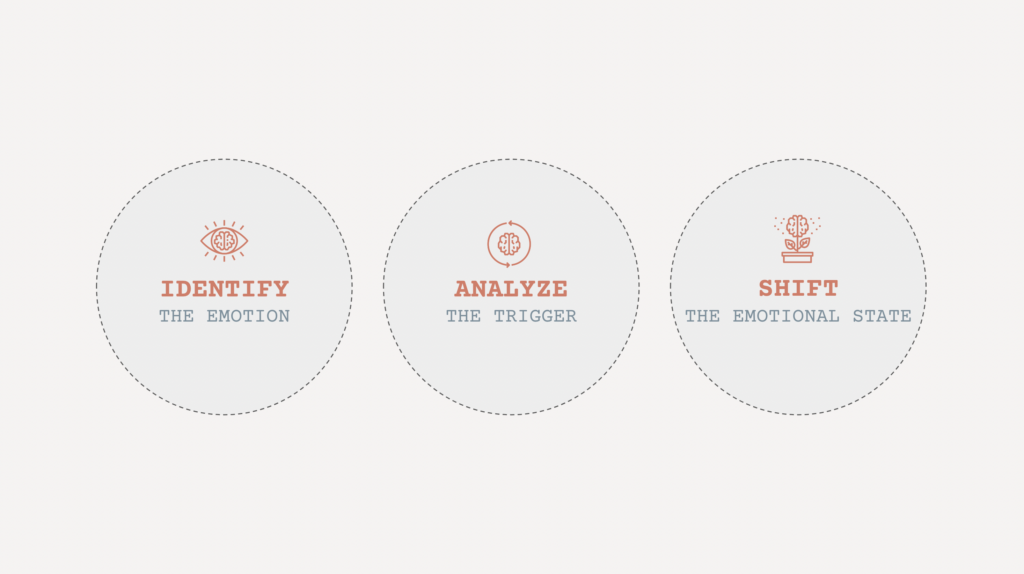It’s easy to stay calm when things are under control. But, sometimes, life happens. A deadline is moved up. Your train is canceled. Your luggage gets lost. Then, your heartbeat goes faster. You can feel the tension in your muscles. Your breathing accelerates. That’s it: You’re stressed.
Psychologists often say that our freedom lies in the gap between stimulus and response (this quote is often misattributed to Viktor Frankl). Although you cannot control many of the external events that impact your life, that liminal space offers an opportunity to choose how you react to negative triggers and to regulate your emotions.

1. Identify the emotion
When we’re stressed because of external factors, this can translate into anger, disappointment, or resentment. The first step is to pinpoint exactly what emotional state you’re in and to remind yourself that this is just a state, which means that you have the power to alter it.
Neuroscientist Antonio Damasio explains how the relationship between the body and the mind shapes our conscious experience. More specifically, what we identify as emotions are just patterns in our body, such as our rate of breathing, our blood flow, or constriction in our gut.
By becoming aware of these patterns, a skill called interoceptive awareness, we can gain back control over the corresponding emotions.
Start by considering the five main categories of negative emotions:
- Anxiety: worry, fear, nervosity, panic, etc.
- Anger: irritation, frustration, rage, etc.
- Guilt: culpability, remorse, etc.
- Sadness: despair, hopelessness, etc.
- Shame: embarrassment, humiliation, etc.
Try and find the closest word possible to describe how you feel. This is not about judging the emotion. You are just putting a label on it to illuminate the relationship between your body and your mind. Once you found the right word, move onto the next step.
2. Analyze the emotional trigger
The trigger may seem obvious at first glance. Maybe someone was rude to you or canceled on you last minute. Still, it is crucial to take the time to go deeper and understand the underlying mechanics that connect the trigger to the negative emotion.
You need to approach this step from a place of genuine curiosity. Be honest with yourself. What are the things you feel you are not getting? What is the need that isn’t met?
Organizational psychologist Dr. Marcia Reynolds created a list of the most common unmet needs, which can be a great place to start. Do you need…
- Acceptance
- Attention
- Autonomy
- Balance
- Being in control
- Being liked
- Being needed
- Being right
- Being treated fairly
- Being understood
- Being valued
- Comfort
- Consistency
- Feel included
- Freedom
- Fun
- Independence
- Love
- New challenges
- Order
- Peacefulness
- Predictability
- Respect
- Safety
Dr. Reynolds recommends choosing three unmet needs from this list. These unmet needs, when combined together, form an equation which results in your negative emotional trigger.
For instance, let’s say that your client suddenly moved up a deadline without consulting with you. Your equation could look something like this:
trigger = lack of consistency + respect + feeling includedOr, if you’ve been suddenly asked to deliver a big presentation without much time to prepare, it could look like this:
trigger = lack of predictability + peacefulness + being in controlThink about a recent stressful experience, and see if you can come up with your equation for this specific event.
3. Shift your emotional state
Now that you’ve recognised your emotional state and analyzed the trigger, you can actively shift your emotional state by regulating your nervous system. Remember the gap between stimulus and response? The third step is about exploring this space with curiosity and self-compassion.
Depending on where you are, you can use one of the following exercises to effectively regulate your emotions:
- Walking meditation. Find a quiet place with enough room to walk around — a place as small as 10 by 10 feet / 3 by 3 meters is enough — and start to walk slowly while letting go of the emotions attached to the negative trigger. Focus on the sensations of standing and the movements that keep your balance.
- Conscious breathing. Breath to relax your body and clear your mind, developing a soft awareness of your breath as it moves in and out of your body. Let your breath direct the flow of your emotions and release the tension in your body.
- Gratitude practice: Gratitude has many benefits, including a positive impact on relationships, work performance, and even physical health. Think about three things you’re grateful for and write them down in your notes or your journal.
- Stretching: Clench and release your fists. Roll your head around. Allow for the full range of motion across various muscle groups. Gentle stretches will increases blood flow and circulation to your muscles and your brain, helping regulation your emotions.
- Doing nothing: Sometimes, the best you can do is simply feel whatever needs to be felt. You can lay down, close your eyes, hug yourself — just listen to what your body needs to process those emotions.
As always, there’s no quick hack that applies to everyone. Just like a scientist, try different techniques and see which ones work best for you.
It may sound cheesy, but it does boil down to one belief: that even though you’re not in control of these stressful external events, you can regulate your emotions. Even if you don’t apply the exact techniques outlined above, this belief is in itself powerful enough to help you manage those negative triggers.
Note: A previous version of this article suggested power posing as a technique to manage negative emotional triggers, but a later study found that power posing doesn’t work. This is a good reminder that strategies based on the latest science can be later debunked.
